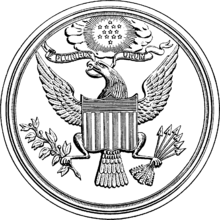Michigan in the American Civil War
 |
|
Union states in the American Civil War |
|---|
|
| Border states |
|
| Dual governments |
| Territories and D.C. |
|
Michigan made a substantial contribution to the Union during the American Civil War. While the state itself was far removed from the combat theaters of the war, Michigan supplied a large number of troops and several generals, including George Armstrong Custer. When, at the beginning of the war, Michigan was asked to supply no more than four regiments, Governor Austin Blair sent seven. Upon the arrival of Michigan's 1st volunteers President Abraham Lincoln was prompted to remark, "Thank God for Michigan.".[1]
Military contribution
More than 90,000 Michigan men, nearly a quarter of the state's male population in 1860, served in the war.[2] In addition to the approximately 600 men who joined the Union Navy, Michigan raised 34 regiments of infantry volunteers, one regiment of sharpshooters, eleven cavalry regiments, one engineer regiment, and numerous small independent units.
Among the more celebrated units was the 24th Michigan Volunteer Infantry, which, as a part of the famed Iron Brigade, suffered considerable losses at the Battle of Gettysburg while defending McPherson's Ridge. George Armstrong Custer's "Michigan Wolverine" Cavalry effectively battled J.E.B. Stuart at Gettysburg on the East Cavalry Field.
Several Union generals hailed from Michigan, including: Custer, Elon J. Farnsworth, Byron Root Pierce, Orlando Metcalfe Poe, Israel Bush Richardson, and Orlando B. Willcox.
Casualties
| “ | Ah! yes, many a hand that vigorously grasped these Flagstaffs and led the van, now lies crumbling in the grave; and not color-bearers alone, but nearly 15,000 others who fought beside them—the flower of Michigan—return not to receive your thanks and the plaudits of their grateful countrymen.
- General O. B. Willcox, Presentation of Civil War Flags to the State, July 4, 1866[3] |
” |
14,753 Michigan soldiers died in service, roughly 1 of every 6 who served. 4,448 of these deaths were combat deaths while the majority, over 9000, were from disease, a constant fear in crowded army camps with poor food, sanitation and exposure issues and pre-modern medicine.[4] This put Michigan's loss at sixth highest among the Union states (the non-state U.S. Colored Troops losses also exceeded Michigan's).
Homefront
Michigan actively participated in the American Civil War sending thousands of volunteers.[5] A study of the cities of Grand Rapids and Niles shows an overwhelming surge of nationalism in 1861, whipping up enthusiasm for the war in all segments of society, and all political, religious, ethnic, and occupational groups. However by 1862 the casualties were mounting and the war was increasingly focused on freeing the slaves in addition to preserving the Union. Copperhead Democrats called the war a failure, and it became more and more a partisan Republican effort.[6] Michigan voters in remained evenly split between the parties in the presidential election of 1864.[7]
See also
- List of Michigan Civil War Units
- History of Michigan
References
- ↑ "Michigan Department of Military and Veteran Affairs". State of Michigan. Retrieved 2010-06-14.
- ↑ "Michigan Civil War Research". State of Michigan, Department of History, Arts and Libraries. March/April 2002 Volume 4, Number 2. Retrieved 2007-06-17. Check date values in:
|date=(help) - ↑ "Rally round the Flags". Michigan Department of Arts, History and Libraries. Retrieved 2007-06-17.
- ↑ "Deaths of Union Forces, by State 1861-1865". Retrieved 2007-06-17.
- ↑ Robert E., Mitchell, "Civil War Recruiting and Recruits from Ever-Changing Labor Pools: Midland County, Michigan, as a Case Study," Michigan Historical Review, 35 (Spring 2009), 29–60.
- ↑ Martin J. Hershock, "Copperheads and Radicals: Michigan Partisan Politics during the Civil War Era, 1860-1865," Michigan Historical Review (1992) 18#1 pp 28-69
- ↑ Peter Bratt, "A Great Revolution in Feeling: The American Civil War in Niles and Grand Rapids, Michigan," Michigan Historical Review (2005) 31#2 pp 43-66.
Further reading
- Bak, Richard. A Distant Thunder: Michigan in the Civil War (2004). 239 pp.
- Bratt, Peter. "A Great Revolution in Feeling: The American Civil War in Niles and Grand Rapids, Michigan," Michigan Historical Review vol. 31#2 (2005) pp 43+. online
- Dilla, Harriette M. Politics of Michigan, 1865-1878 (Columbia University Press, 1912) online at Google books
- Hershock, Martin J. "Copperheads and Radicals: Michigan Partisan Politics during the Civil War Era, 1860-1865," Michigan Historical Review 18 (Spring 1992)
- Taylor, Paul. "Old Slow Town": Detroit during the Civil War (Detroit: Wayne State University Press, 2013). x, 248 pp.
| ||||||||||||||||||||||||||||